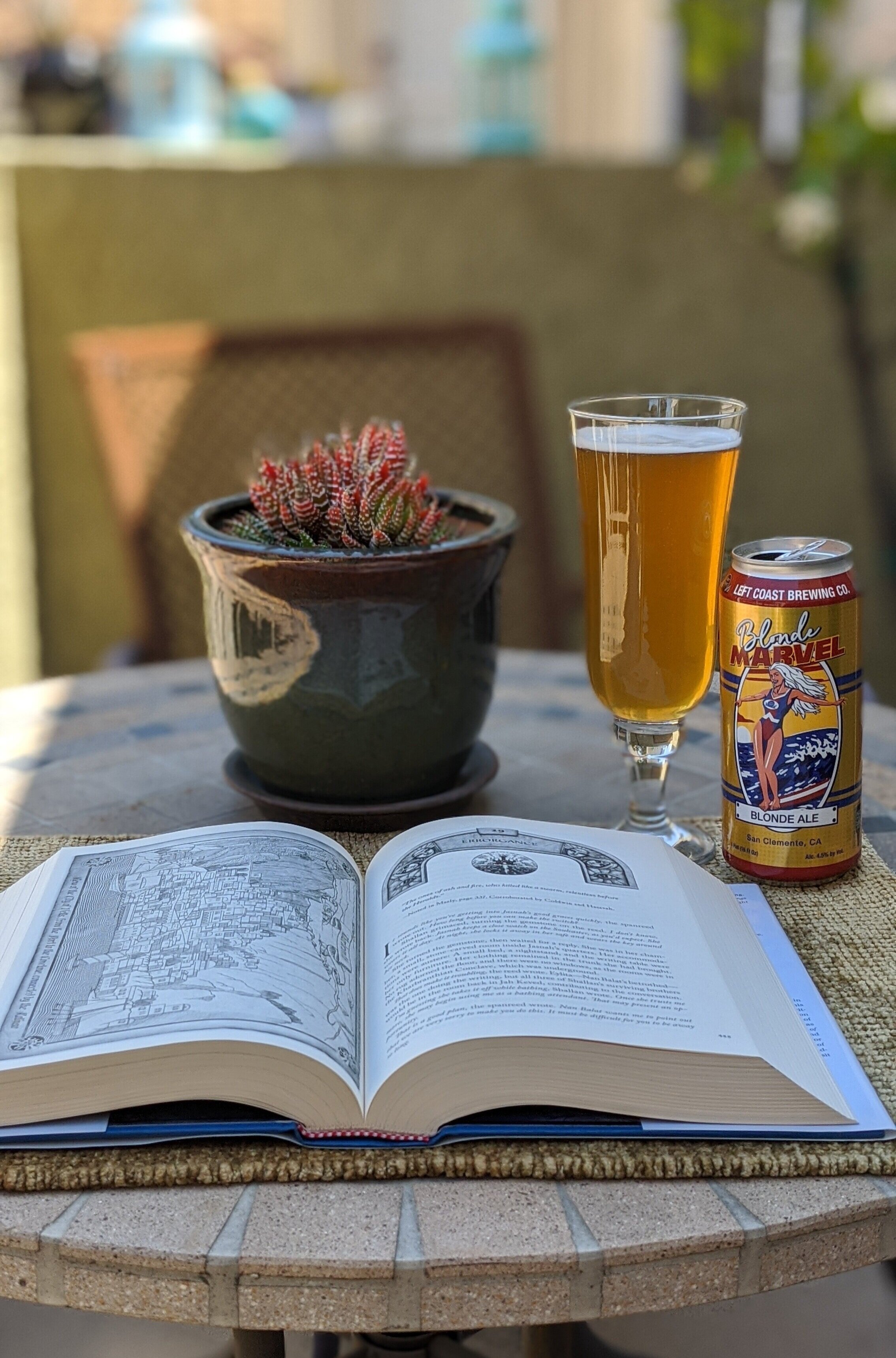I just counted and I have 220 unread books on my bookshelves at home, a figure which plays nicely with the title of this article. I have written previously about my personal experience with tsundoku (積ん読) which the BBC gently identifies as “the art of buying books and never reading them”. I think many of us in the #bookstagram community are guilty of this. Guilty? That makes it sound like we are committing a crime. To say we suffer from or live with tsundoku may be a little closer to the mark because it suggests this condition may very well be on the spectrum of a mental illness. Nothing so extreme as schizophrenia or sociopathy, but certainly with one toe in the waters of obsessive compulsive disorder.
For me, it is a compulsion that I have been trying hard to control. Until last year, if I ever entered a bookstore, I would not leave empty-handed. If there is a series I am interested in reading, I will buy as much of the series as is available. What if I read the first volume of the series and do not like it? If it is a long-running series like Robert Jordan’s The Wheel of Time — fourteen volumes written over a period time just one week shy of twenty-three years — then I have just spent hundreds of dollars and taken up several feet of shelf space for something I will probably never read. I know for a fact that many others do this as well and quite a lot of us can be found on Instagram, posting photographs of our voluminous book collections in tiny, artsy cries for help. Sometimes I will luck into a great series like The Expanse by James S.A. Corey. I now own seven of the eight chunky volumes, but have only read the first two. Fortunately, I absolutely adore them and I am quite confident that I will enjoy the rest of the series because after reading reviews written by people I trust, it sounds like the series only gets better. But in general, I just buy books. I buy them as though owning them will keep me alive. I love having them around me. I am comforted by them. Even knowing that I will die before I have the chance to read some of these tomes, just having the author’s ideas within arm’s reach makes me feel good.
My book-related social media community exists mostly on Instagram — and not Goodreads, which surprised me — and it is through users like Whitney who manages @theunreadshelf Instagram account and www.theunreadshelf.com that I have begun to rein in my tsundoku. I have not bought a book for myself in at least half a year and I am really proud of that. Part of it hurts because I love wandering the aisles of a bookshop, pulling an interesting book off the shelf and trotting to the cashier with it, driving home with it resting comfortably on the passenger seat like a newly adopted puppy. Buying books supports the author who wrote it, the publisher and agent who gave it a chance, the bookstore who made it physically available for purchase. Not buying a book makes me feel as though I am not participating in that economy.
To combat that unpleasant feeling, I am trying to be more active in the @bookstagram community and with Goodreads and with this website. Word of mouth is another positive way to support authors and the books you love. This involves writing reviews — I say “review” but prefer to think of my articles as just my experience with the book because I do not follow the rigid book review format — posting photographs of books on Instagram, checking out books from my local library. Speaking of libraries, I signed up for my first library card in three decades at the beginning of this year. I have since checked out and read four books:
Mrs. Frisby and the Rats of NIMH by Robert C. O’Brien — the subject of the January episode The Hero’s Journey Podcast — The Secret of NIMH
All You Need Is Kill by Hiroshi Sakurazaka — the subject of the February episode of The Hero’s Journey Podcast — Edge of Tomorrow
We Can Remember It For You Wholesale by Philip K. Dick — the subject of the March episode of The Hero’s Journey Podcast — Total Recall
The Big Sleep by Raymond Chandler
Sadly, my library patronage has been temporarily halted due to the COVID-19 pandemic, but I intend to return as soon as it is safe to do so. My local library branch is about a mile and a half from my home so if I walk, I not only have the opportunity to visit the library and everything it has to offer, but I also squeeze in a three-mile exercise walk. And while I walk to the library, I listen to an audiobook on Audible so I am not only accomplishing exercise goals, but also reading and library goals at the same time. Hashtag multitasking.
I have digressed. The purpose of this article is to challenge myself to read twenty books that I already own before the end of the year 2020. As I stated at the top, I have 220 options. With the first quarter of the year now in the past, I have already made some progress in that four of the nine books I have read this year are from my Unread Shelf. The others are the aforementioned library books and a literary journal. I do not count the library books because I do not own them. I read them because I featured them and the movie based upon the books on my podcast. Did I mention I have a podcast? I have a podcast. The Hero’s Journey. Check it out! My co-host Jeff Garvin and I have a few laughs, a themed adult beverage or two, and break down popular books and films using Joseph Campbell’s hero’s journey myth structure. We are really proud of our work and would love it if you would give us a chance to entertain you.
I digressed again. Darn it. 20 books for 2020. Okay, here goes:
The Water Knife by Paolo Bacigalupi (complete)
A Rage for Order by Robert F. Worth (complete)
Where Gods Fear to Go by Angus Watson (complete)
Anyone You Want Me To Be by John Douglas and Stephen Singular (complete)
The Way of Kings by Brandon Sanderson (complete)
The Windup Girl by Paolo Bacigalupi (complete)
and here is where I have to challenge myself by actually choosing fourteen books off my shelf and committing to read them before the end of the year…
…so here we are, not necessarily in this order…
The Lightness of Hands by Jeff Garvin (complete)
The Bad-Ass Librarians of Timbuktu by Joshua Hammer (complete)
Between the World and Me by Ta-Nehisi Coates (complete)
Badluck Way by Bryce Andrews (complete)
How to Find Love in a Bookshop by Veronica Henry (complete)
The Grey Bastards by Jonathan French
How Like a God by Brenda W. Clough (complete)
People of the Book by Geraldine Brooks (complete)
The Zone of Interest by Martin Amis (complete)
Hamilton: The Revolution by Lin-Manuel Miranda and Jeremy McCarter (complete)
Bannerless by Carrie Vaughn (complete)
The Last Bookaneer by Matthew Pearl (complete)
Abaddon’s Gate, Book 3 of The Expanse by James S. A. Corey
‘Salem’s Lot by Stephen King (complete)
By the gods, that is a list. Again, the goal here is to read books I already own. Once I finish them, I will either keep them if I absolutely love them or donate them to the library so someone else can read them. I visit Santa Barbara frequently and behind Brass Bear Brewing on Anacapa Street, there is a red telephone booth that has been converted into a Little Library. I have left books there before and they are always gone the next time I pass through. I don’t know if someone takes them to keep or if the local library swings by to collect them. It matters not to me as long as someone else is gaining access to these books.
So there it is! Twenty books I plan to read in 2020. Twenty books I already own. How many books are on your Unread Shelf? How many do you plan to read this year?







